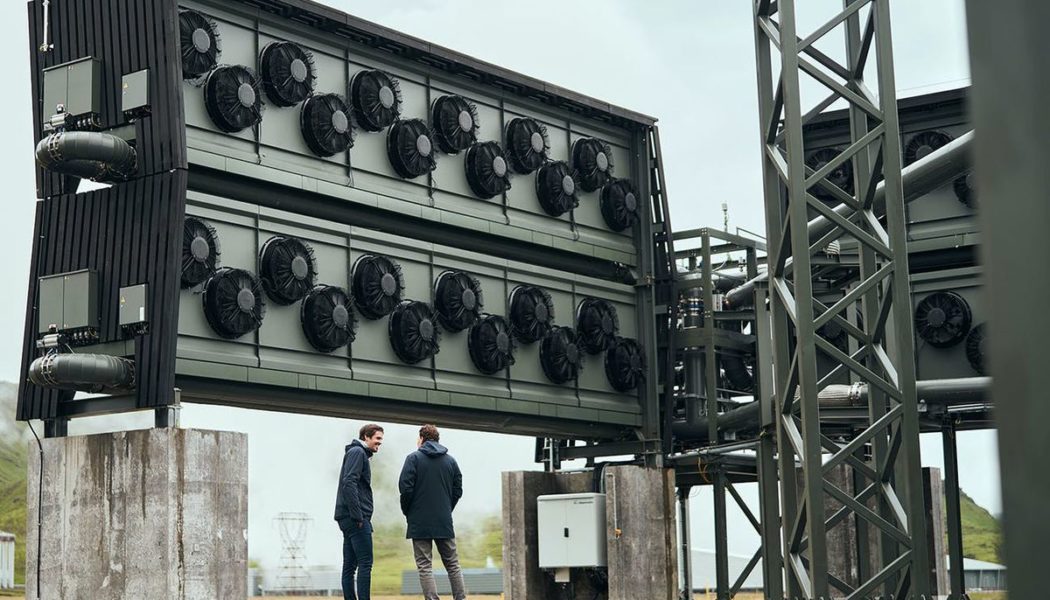The biggest industrial plant yet to suck tons of planet-heating carbon dioxide out of the air came online yesterday in southwest Iceland. Direct air capture plants like this one have been hyped up lately by world leaders and giant corporations — notably Microsoft — that are looking to erase their legacy of greenhouse gas pollution.
This particular operation is ideally located to test the emerging technology. The new plant, built by Swiss company Climeworks, is powered by renewable energy from a geothermal power plant nearby. Climeworks also plans to lock the captured CO2 away in basalt rock formations just three kilometers from the geothermal plant. It’s a storage plan that likely bypasses the need for controversial new carbon dioxide pipelines.
“It’s going to be, I think, an interesting test case,” says David Morrow, director of research at the Institute for Carbon Removal Law and Policy at American University. “But it’s also sort of a baby step in the big scheme of things.”
Climeworks’ new direct air capture plant, called Orca for the Icelandic word for energy, will be able to draw down 4,000 tons of carbon dioxide annually. That’s about how much 790 passenger vehicles might pump out in a year — not a huge amount, even though it’s the largest operation of its kind in the world.
The new plant is surprisingly compact. Imagine a shipping container that’s open on one side to reveal twelve giant fans. The plant is basically just eight of those containers, stacked two by two.
[embedded content]
Climeworks uses a method called solid direct air capture to trap CO2. Here’s how it works: The fans suck in air. The air passes over a special solid sorbent filter that traps the carbon dioxide. Climeworks wouldn’t get into too much detail about how its filters work in an interview with The Verge, other than saying that it uses a base to attract CO2, which is mildly acidic. When the filter is fully saturated, it’s time for step two in the process. The unit heats up the filter to about 100 degrees Celsius (212 degrees Fahrenheit), which releases the trapped carbon dioxide.
Once the CO2 has been separated out of the air, it heads through pipes to an adjacent building where it can be prepped to be permanently stored. Here, it’s mixed with a lot of water — about 27 tons of water for every ton of carbon dioxide. That slurry then travels just a few hundred meters (about a quarter of a mile) away before it is injected deep into the ground. The carbonated water reacts with basaltic rock, creating carbonate minerals. Over the course of two years, what was once a kind of sparkling water becomes solid rock.
Climeworks has partnered with the company Carbfix to keep the captured CO2 safely locked away in Iceland’s basalt rock formations. The two companies have already tried this out in a pilot project, but Orca is the pair’s first commercial-scale operation.
:no_upscale()/cdn.vox-cdn.com/uploads/chorus_asset/file/22836822/ada4e9dd_a5e0_40c6_8ecd_038ac83e17f3_Orca_Launch_Website_Image.jpeg)
Climeworks’ two other commercial-scale direct air capture plants turn the carbon dioxide into a product used as fertilizer or in fizzy drinks. That CO2 escapes back into the atmosphere relatively quickly. But trapped in rock, Carbfix thinks the CO2 captured by Orca can be safely sequestered for thousands of years. While basaltic rock is relatively common around the world, volcanically active Iceland is particularly suited for storing carbon dioxide because it has relatively younger basalt. Fresh basalt is a better home for the captured CO2 because it’s more porous — giving the carbon more nooks and crannies to fill.
By siting Orca in the same remote location where the CO2 will be stored, the operation avoids one of the potential pitfalls with carbon removal: creating a new network of pipelines to transport captured carbon dioxide. There are already some pipelines that move CO2 so that it can be shot into the ground to force out oil reserves, a process called enhanced oil recovery. One such pipeline ruptured last year in Mississippi, hospitalizing residents of a small, majority-Black community.
The other advantage of the plant’s location is its proximity to a geothermal energy plant, which provides the plant with a constant supply of waste heat and renewable energy. That, paired with Climeworks’ solid direct air capture process, gives Orca an edge over other competitors. Even larger direct air capture plants are scheduled to come online in Texas and Scotland in coming years, but those use a different filtration process that requires vastly more heat and energy. As a result, they’ll likely rely on a combination of renewable energy and natural gas.
“If you’re in the business of removing CO2 from the air, you want to emit as little fossil fuel CO2 as possible. Otherwise, the process is not net negative or net removing,” says Christoph Beuttler, Climeworks’ head of climate policy.
Cost is another hurdle still keeping the direct air capture industry from growing large enough to make a huge dent in global greenhouse gas emissions. Microsoft, which pledged last year to capture all of its historical emissions by 2050, is both an investor and a customer of Climeworks. Microsoft and other companies can purchase captured CO2 from Climeworks for around $600 a ton, offsetting a ton of their own pollution in the process. In its 2020 fiscal year alone, Microsoft was responsible for the equivalent of 11,164,000 metric tons of carbon dioxide. Multiply that by $600, and Microsoft would face a bill of nearly $6.7 billion for just one year’s worth of pollution.
Unless the price can come down significantly, it might not make much financial sense to tackle climate change this way. And some environmentalists worry that focusing on building up this technology could take resources away from other climate solutions, while taking the pressure off companies to quit burning fossil fuels.
“One thing people worry about is that all these companies making that net-zero pledges will just use direct air capture instead of cutting emissions,” Morrow says. “But it strikes me as very unlikely that direct air capture would get cheap enough anytime soon for that to make sense.”
So while direct air capture might play a small role in helping the world trap some planet-heating emissions, it’s no replacement for deep cuts to fossil fuel pollution in the first place. “It is at most a supplement that can help us reduce climate change,” Morrow says. “But it can’t take the place of cutting emissions.”









